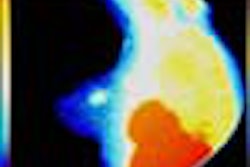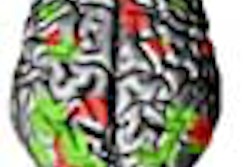The value of ultrasmall superparamagnetic iron oxide (USPIO) contrast agents was presented in a pair of papers at the European Congress of Radiology earlier this month.
Dr. Stephan Schmitz and his colleagues from the Free University of Berlin had incidentally observed USPIO uptake in aortic and arterial wall segments in patients who had originally received the MR contrast agent for staging lymph node metastases. They reasoned that USPIO might be used as a contrast agent to enhance the MR imaging of atherosclerotic plaques.
The researchers reviewed the MR images of a group of 20 patients, 19 male and 1 female, ranging in age from 29 to 78 years, who had bladder or prostate cancer. This group had undergone MR on a 1.5-tesla machine using a T2-weighted high-resolution gradient-echo sequence prior to, and 24 to 36 hours after, intravenous injection of 2.6mg Fe/kg of USPIO contrast. The images were reconstructed in 6-mm slices for interpretation.
The authors analyzed each patient's aorta, and the common, external, and internal iliac, as well as both superficial femoral arteries. They found that USPIO uptake occurred in plaques showing an increased endothelial permeability and macrophage phagocytosis as signs of inflammatory plaque activity.
Two radiologists, who were blinded to the study outcome, had to reach a consensus as to image quality to determine a positive finding. A positive finding was defined as an area of pronounced signal loss on post-contrast images that was clearly confined to the arterial wall, and that was absent in the pre-contrast examination or had increased in size since then. Such a finding was observed by the readers in 1 to 3 arteries in 7 of the 19 patients.
The data showed an accumulation of USPIO particles in atherosclerotic plaques. According to Schmitz, the pronounced signal loss in the wall of the aorta and pelvic arteries seen in part of this patient population after intravenous USPIO administration, "strongly suggests that this contrast agent accumulates in human atherosclerotic plaques."
Schmitz and his group decided to move forward with this data and perform a preclinical evaluation of USPIO-enhanced direct thrombus MR imaging. The hypothesis the researchers set out to test was to see if USPIO would diffuse into fresh thrombi. The results were published in the August 2000 issue of Investigative Radiology (Vol.35:8, pp. 460-71).
The researchers made the selection of nonendothelialized fresh thrombi because of the long plasma half-life of this blood-pool for MR contrast. They induced stagnation thrombi of different organizational stages (1, 3, 5, 7, or 9 days) into the external jugular vein of 25 rabbits (5 groups of 5 rabbits for each stage).
The authors then performed direct thrombus MR imaging using a fat-saturated T1- weighted gradient-echo sequence before, and 24 hours after, injecting 200 µmol of the 25-nm particle-size USPIO. The length of the thrombi visualized on 3-D reconstructions from the MR data was compared to x-ray venography and histology.
Agreement on thrombi size was made using predetermined length ratio, defined as thrombus length at T1-weighted MR/true thrombus length. In addition, T2-weighted gradient-echo images were also generated on the 1.5-tesla MR scanner and were scored semi-quantitatively.
The authors found that the T1-weighted 3-D reconstructions appeared as hyperintense structures on the images. The images also showed that the mean length ratio increased significantly from pre- to post-contrast MR at a thrombus age of 3 days, 5 days, and 7 days -- but not at 1 day or 9 days. And, no signal change was observed on the T2- weighted images.
Schmitz noted that endothelial dysfunction and the blood-pool effect did allow accumulation of USPIO in the thrombus as the researchers had hypothesized. He and his research team plan to continue testing USPIO-enhanced direct thrombus MR imaging because of its potential for the detection and age characterization of thrombi.
By Jonathan S. BatchelorAuntMinnie.com staff writer
March 16, 2001
Related Reading
Supersmall MR contrast agents could be a huge success, February 22, 2001
Click here to post your comments about this story. Please include the headline of the article in your message.
Copyright © 2001 AuntMinnie.com



















